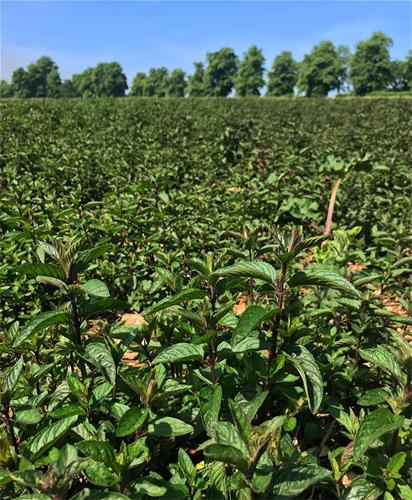Black Mitcham peppermint was first cultivated around 1750 in the county of Surrey’s Mitcham district, just southwest of London. The “black” part of the name comes from the dark color of the plants. Under grey English skies, the deep purple undersides of the leaves can appear black in some crops. For 200 years, Black Mitcham was popular across England. It’s slow to mature but produces plenty of essential oil—the flavor behind English tea and confections. Heirloom varietals like Black Mitcham became so well-known and well-loved that even across the channel in France, peppermint became known by the name “menthe Anglaise.”
That all changed in World War II. Herb farms across the English countryside were plowed under to grow staple crops for the war effort. For half a century, nobody in England grew mint commercially. Twenty years ago, Sir Michael Colman—who spent most of his career running the family business you’ve probably heard of, Colman’s Mustard—turned that around when he began planting Black Mitcham mint on the family estate in Hampshire.
Under the direction of master farmer Ian, the estate grows mint, lavender, and chamomile, as well as being home to hundreds of acres of woods filled with birds and other wildlife. To get to the peppermint fields, you take a short drive down a shady lane under the tall, leafy trees. Stepping out from the cool of the woods into the bright sunshine of the field on a clear June morning, you’re immediately immersed in the bright, spicy aroma of peppermint. It’s like stepping into a bath of mouthwash: invigorating, refreshing, powerful—but also pleasant (no alcohol burn!). That inescapable peppermint aroma is the result of tiny droplets of essential oils that evaporate when the warmth of the sun heats the countless mint leaves. It infuses the air with spice and punch.
In August, it’s time to capture those essential oils.
Mint plants are ready to harvest when they’re about two feet tall, but after twenty years of experience Ian can tell when it’s time to harvest the plants just by running his hands across them. After being cut, the mint will dry in the sun for a day or two to start concentrating the flavors. The mint then travels a short ways across the farm to the on-site steam distiller to extract the oil. The distiller works essentially the same way as how a gin still works when it extracts the essences of its flavoring botanicals: steam passes across the mint, heating it to the point that the essential oils evaporate out of the leaves. Then the oil-laden steam is cooled, condensing the oils separately so they can be collected. It takes about 3 hours to distill one truckload-sized batch of mint. A full truckload packed floor to ceiling distills down to just 25 kilos—a little more than 55 pounds—of peppermint oil.
After distilling, the oil is volatile. To control for quality and to develop the particular desired flavor profile, each year’s crop of oil will be held to settle and mature for nearly two years before it’s ready to use. Crops from various years are never mixed, so each harvest can be used when it’s at its peak.
To showcase the flavor of their mint, Michael partnered with an English confectioner to make chocolate mint creams.
What they came up with are the peppermint patties of your dreams: a rich chocolate shell that crackles between your teeth to release a silky, molten mint center. The mint is arresting. Bright and fresh, each piece a small, tingling bite of a sunny morning in a peppermint field. The flavors are pure and bold enough to win over confection snobs, but approachable enough for kids to love them, too. When my colleague Brad took a box home to “research” them for “work,” the box disappeared from his office and then mysteriously showed up hours later under his seven-year-old daughter’s pillow.
I think she had the right idea eating them in bed. They’d be equally good at the kitchen table or on the sofa as an afternoon snack or after dinner treat. A box of twelve makes a beautiful gift—but it’s slender enough to hide all for yourself, too.

